Analyzing Intel Core M Performance: How 5Y10 can beat 5Y71 & the OEMs' Dilemma
by Brett Howse & Ian Cutress on April 8, 2015 8:00 AM EST3DMark Sky Diver Results
Most of the previous benchmarks were day to day tasks. Some involved the GPU, but it was never the focus. We will now move on to benchmarks which focus on GPU performance to see what kind of an effect this can have. Remember, the TDP of Core M is 4.5 watts including the integrated graphics, so any thermal room needed for graphics is going to come at the expense of the CPU. 3DMark Sky Diver is aimed for gaming laptops and mid-range PCs, so it is a bit too much load for integrated graphics. But it does feature DirectX 11 and includes both graphics and physics tests. The benchmark is around five minutes long.
We can see that the Core i5 continues shrugging off these tests. While the SoC did heat up, the GPU frequency was flat throughout the results. This is quite a bit different than all of the Core M processors, which had to throttle both the CPU and GPU as needed. It is very interesting especially in the UX305 results to see that the GPU is throttled on high CPU workloads to give more headroom for the CPU, which you can see on the third heat spike in its graph. This would be the physics test, which relies heavily on the CPU. The Dell Venue 11 and Yoga 3 Pro had very different temperature curves, and the Yoga 3 Pro had to throttle the GPU quite a bit to stay at its target SoC temperature.
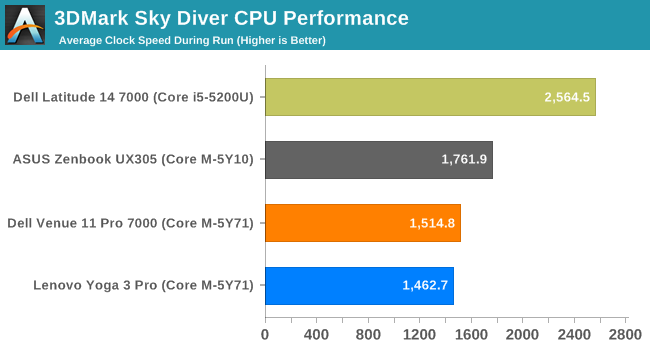
Looking at the average CPU frequencies reaffirms what we have seen in previous results. The ASUS, despite having the lowest turbo frequency, has the highest average for the Core M devices. But it is the GPU frequencies which are the most important in this test.
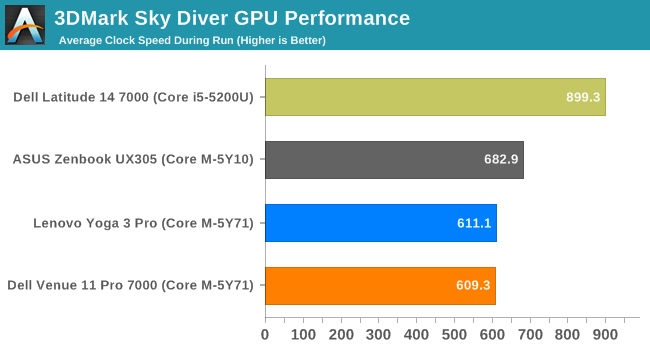
All of the Core M devices had to throttle the GPU to some extent, but the ASUS did the least. The Yoga 3 Pro and Dell Venue 11 Pro were basically tied in average GPU frequency for the duration of this test. GPU workloads can pull a lot of power into the SoC, which can raise temperatures as we will see in the next graph.
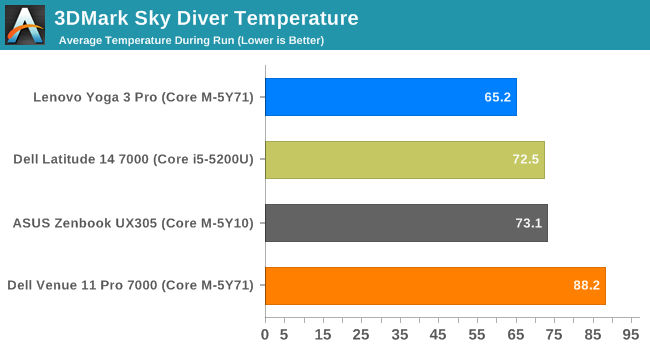
Looking at the SoC temperatures explains the results. The Yoga 3 Pro has an average of 65.2°C, which is the target temperature for the Yoga. This means it was not able to leverage the breaks in workloads to ramp up its higher turbo frequencies when needed. The Dell Venue 11 is at almost 90°C for the benchmark, and that is also its limit. The ASUS, with its better cooling, manages to basically mirror the Core i5 for SoC temperature.
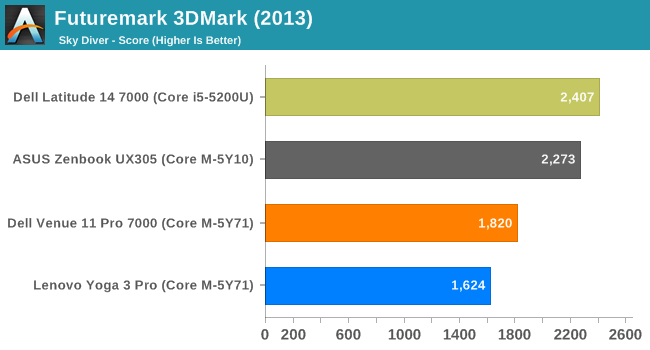
The excellent cooling of the ASUS form factor shines in the GPU tests. For the overall score, it comes very close to the Core i5. Both of the 5Y71 devices struggle under sustained GPU workloads, as the scores confirm.


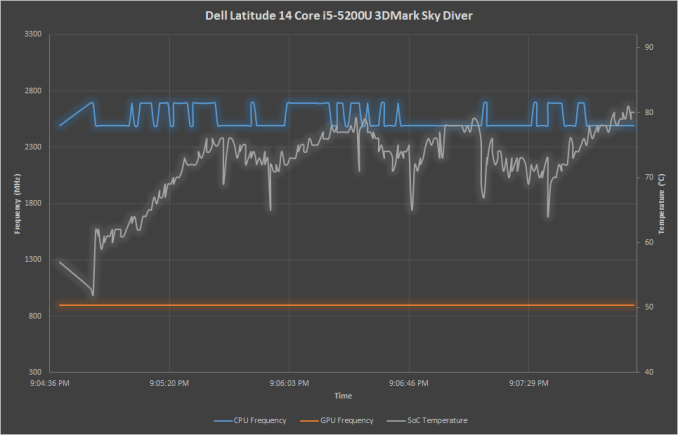
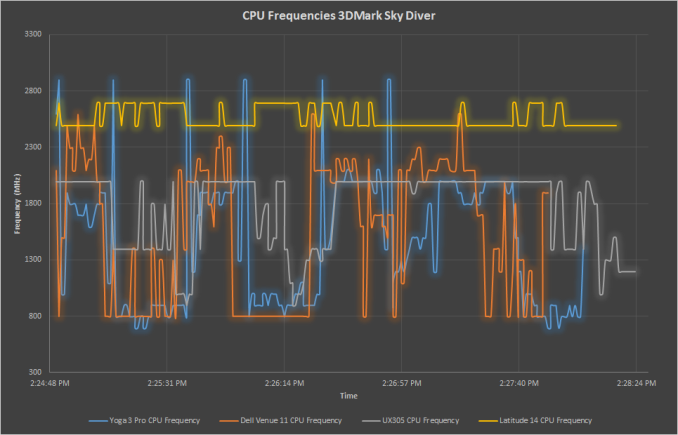
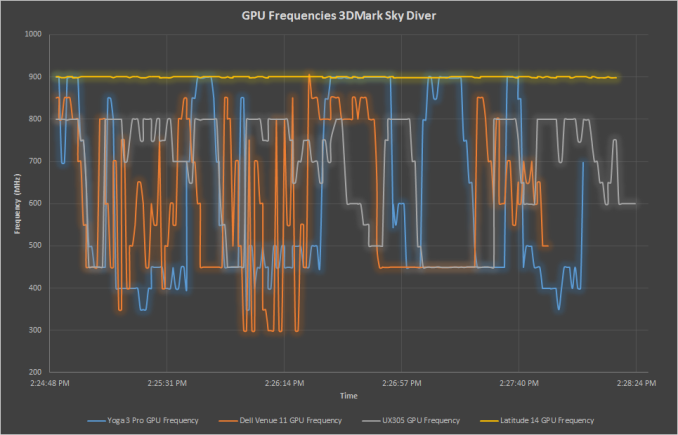
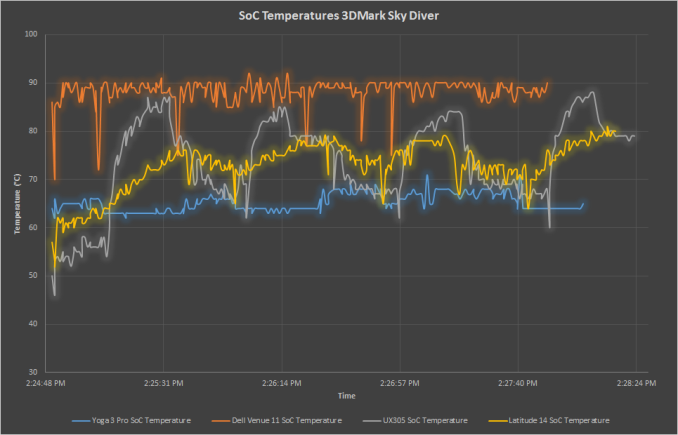








110 Comments
View All Comments
jjj - Wednesday, April 8, 2015 - link
You insist on only showing low power CPU results , because putting them properly in context would hurt sales right? God forbid you include laptops....And today somehow you decided to fully ignore AMD too.
Maybe stop working for Intel and serve your readers instead.
MrSpadge - Wednesday, April 8, 2015 - link
Dude.. WTF?This is an evaluation of what Core M is and what this means for devices using it. It's neither a comparison to other device and CPU classes, nor a general recommendation of this product.
Michael Bay - Wednesday, April 8, 2015 - link
AMD just can`t afford a decent shill anymore.THIS is what they go these days.
xthetenth - Wednesday, April 8, 2015 - link
I guess it's easy to confuse discussions of architectural details for devices that have already been reviewed on this very site with articles comparing those devices to other similar devices when the preexisting reviews contain many of the very comparisons you want.Dorek - Wednesday, April 8, 2015 - link
"And today somehow you decided to fully ignore AMD too."Only because the market does.
Refuge - Wednesday, April 8, 2015 - link
This article was never about comparing the CPU's to AMD or anyone. It was about explaining why we are getting awkward results across the board on the performance of these low TDP Intel parts.Nothing to do with AMD, or even the specific OEM's products either, so much as their construction and heat dissipation performance, but it was only in an effort to further explain the varying results of these low TDP Intel chips.
Pissedoffyouth - Wednesday, April 8, 2015 - link
Haha how does a 4.5w CPU for a laptop have anything to do with a 65w+ desktop CPU?Allan_Hundeboll - Wednesday, April 8, 2015 - link
If he was working for intel he would have included amd's "lowpower" cpuname99 - Wednesday, April 8, 2015 - link
Yeah, it's ridiculous.Why isn't there also a comparison against a POWER8 --- that would DEMOLISH this silly little Broadwell-Y.
And they're going on about how great the power dissipation is? Compare it against an ARM M0 and look who has crazy low power dissipation then!
I demand that every future AnandTech review compare any CPU against every other other CPU in the known universe, no matter how irrelevant the comparison...
lilmoe - Wednesday, April 8, 2015 - link
That price tag makes this the most confusing and out-of-place processor from Intel... Microsoft proved that Haswell-U can power an ultra-thin x86 tablet, have mobile SoC comparable battery life, and price it comparably or even lower than Core M products. All that with the added benefit of better performance...OEMs can take advantage of lower pricing on some Broadwell-U processors, and install a better/thinner active cooling solution with the savings. So where does that put Core M other than "luxury" devices that have no need for "real" performance advantages?
Not for me, thanks... Not at THAT price tag.